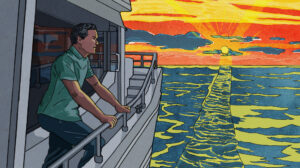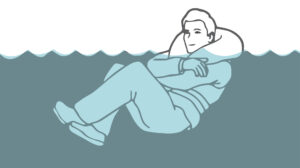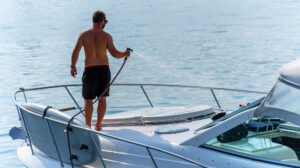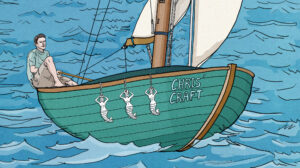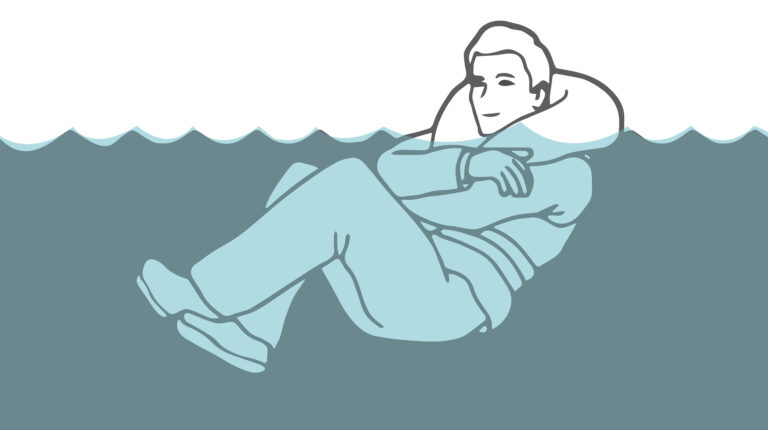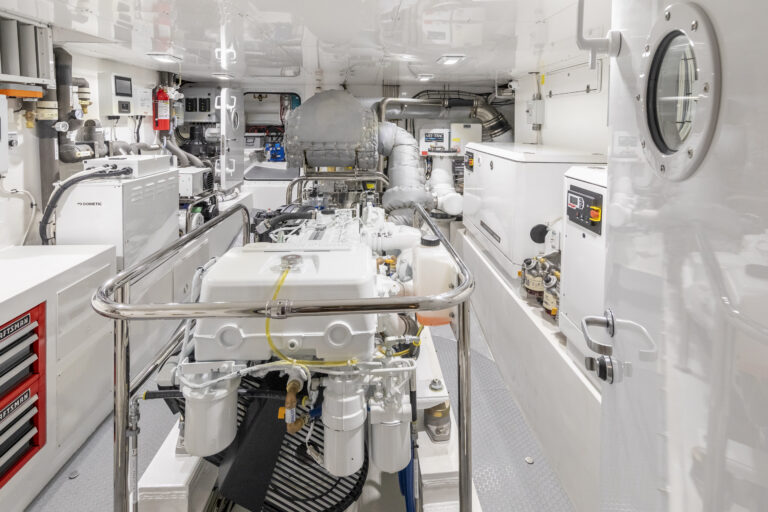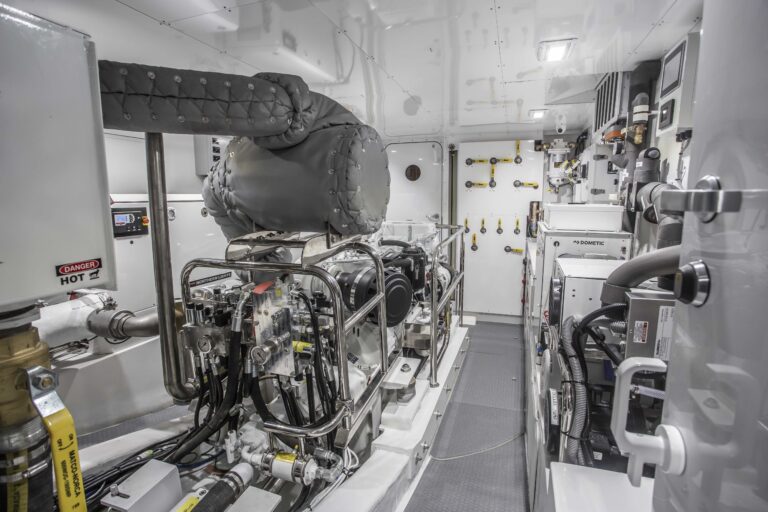The ice stretched across the fjord ahead of Venture in a seemingly unbroken barrier, effectively barring any further progress toward the face of the Sawyer Glacier. Being a responsible captain, Chris Conklin expressed his doubts about continuing. “Let’s keep going,” I responded. “After coming so far we don’t want to give up until we absolutely must.”
We had originally planned to wait a day before navigating the full length of Alaska’s Tracy Arm but we decided to take advantage of this rare day of fine weather to change our plans and keep going. The fjord is 24 miles long, with scenery so spectacular it was hard to know where to turn one’s eyes. Countless waterfalls, fed by the melting snow, cascaded down the face of soaring cliffs with trees growing out of all but the steepest of them.

Increasing amounts of ice obstructed our path—mostly brash ice, which thumped the underside of the hull and was hard to see. Some pieces were sculpted into marvelous shapes resembling fish, pelicans or swans. We passed a gaggle of kayakers in multi-colored kayaks so far off that they were almost invisible except through binoculars.
The ice became more densely packed as we progressed through the twists and turns of the fjord, and we wondered how far we would be able to go before it blocked our progress entirely. We passed harbor seals resting on the ice floes. Some were timid and slid off into the sea early, while others just watched us warily as we approached. Blood stains on some of the floes were evidence of a recent birth and brought home to us the responsibility of keeping clear of floes with evidence of seal activity. We reached the point where the fjord divided into separate channels leading to the north and south faces of the Sawyer Glacier.
CRUNCH TIME
These are tidewater glaciers, meaning that they extend into the sea. The ebb and flow of the water undermines the underside of the ice and huge chunks break off into the water and float away. The face of the glacier at the water’s edge was a deep blue. We launched the tender, and Louisa and I climbed aboard, while Conklin cautiously nudged Venture through the floes toward the face of the glacier until she was brought to a standstill by a floating wall of blue ice.

Using my knees to hold the wheel steady, I drove the tender while shooting video and stills. I have found this works better than trying to relay instructions to the driver. It was Louisa’s job to tell me when we were about to run into something as we proceeded at slow speed through the ice, some of which was colorless and as clear as crystal. Whenever the inflatable came into contact with the floes, it squeaked like a thumb slipping over the surface of a party balloon.
After about an hour, we reluctantly headed down the channel but it was hard to stop taking photos during the return journey. By the time we anchored in Tracy Arm Cove it was almost 8 p.m., but this far north, darkness did not descend until almost 11 p.m. with dawn breaking around 3 a.m.
It was raining when we awoke the following morning, which made us thankful that we had decided to penetrate Tracy Arm the previous day. Overnight, a small iceberg had become stranded on the rocks at the entrance to the cove and, when we re-crossed Tracy Arm Bar, the red, port-hand marker, which the previous day had been missing in the strong tide, had reappeared—although its survival was now being threatened by a beautiful but menacing blue iceberg.
On our way up Endicott Arm, we paused to reconnoiter the approaches to Ford’s Terror, which we planned to enter on the return journey. This spot earned its sinister name from a navy crewman who in 1899 rowed into the fjord at slack water to do some duck hunting. With the turn of the tide, the calm water at the entrance became extremely turbulent with rapids, rooster tails and whirlpools. According to the account, Ford found himself trapped in the maelstrom for six hours dodging chunks of ice. The dogleg entrance was hard to identify at low tide but enabled us to get the lay of the land and identify the hazards.
DAWES GLACIER
As we penetrated deeper up the 40-mile length of Endicott Arm, the sides of the fjord grew ever steeper until they became sheer rock walls bearing the scars of the glacier that had ground its way past them not so long ago. We encountered increasingly large quantities of ice calved from Dawes Glacier. We pressed onward despite ominous thumps and bangs as the hull came into contact with the floes. Our perseverance was rewarded when the ice unexpectedly opened up and we reached open water.

The glacier face now appeared to be only a few hundred yards away but the radar showed it still to be 3 miles distant. Nothing remained in the way of our reaching the towering wall of ice, but discretion made us call a halt while we were still several hundred yards away. It was as well we did, because large slabs of ice were calving from its blue, deeply fissured face.
Under improving weather conditions, we launched the tender, and my friend Louisa Chen and I climbed aboard, armed with cameras. Conklin ran Venture back and forth across the face of the glacier while I took photos and video. On one occasion, I heard a sharp boom coming from one end of the glacier and I held a video camera on that area. Increasingly, large chunks of ice started to break free followed by a large slab, which slid into the sea with a tremendous splash just as Venture entered the frame. Large swells resulted from this collapse but they were smooth and rounded and did not create a hazard.
It was hard to tear ourselves away from this amazing spectacle, but after an hour or so, we reluctantly turned our bows and threaded our way back out through the pack. We stopped to collect some crystal clear ice to cool our drinks.

Our reluctance to leave the glacier had put us behind schedule and it was one hour past high water slack when we reached the entrance to Ford’s Terror. The outgoing tide was beginning to gather speed, but with powerful engines at our disposal, we had no problem negotiating the narrow entrance.
Guidebooks tend to dwell on the alarmist name and the perils of the entrance rather than what awaits inside the narrows. So the stunning beauty of the wonderland within came as a revelation. We had not appreciated, from reading the cruising guides, the outstanding nature of this magical place which was akin to cruising through Yosemite Valley.
To our surprise we found Penguin, a Nordhavn 46, whose crew we had met and come to know much earlier in the trip, already anchored at the head of the northern arm of the fjord together with their friend in a Nordic Tug. Care needs to be taken when anchoring here, as depths drop off rapidly and you could find yourself aground at low tide if you have not watched the depth sounder and paid attention to the tide tables. The only sounds in this exquisitely beautiful spot were those from the nearby waterfall.
COLOR AND TEXTURE
The following morning dawned absolutely calm with filaments of cloud lingering in the still air part way up the peaks. A flock of colorful harlequin ducks scavenged in the outfall from the waterfall. We launched the tender and explored the fjord. We passed through rapids guarding the eastern arm of Ford’s Terror and then down to the main entrance to the fjord, which we sped through without any problem at low water slack. On the return journey, we poked our bows into a narrow cleft in the cliffs, through which cascading waterfalls tumbled over moss-clad rocks into water the color of jade. That evening we enjoyed a delightful evening aboard Penguin, sharing drinks, conversation and tasty hors d’oeuvres.

In a boat the size of Venture, it is safer and more sensible to enter and leave Ford’s Terror at high water slack, which occurs just twice in every 24 hours. This meant being underway at 5:30 the following morning. It was another opportunity too good to miss and I decided to use the tender to gather video and photos of Venture underway and passing through narrows.

I had a great run all the way down through the spectacular fjord and sped out through the narrows ahead of Venture, so that I could film her passing through. A beautiful chunk of floating ice added drama to the scene. Although the sky was overcast, there was no rain, which would have made photography very difficult. Just beyond the entrance, Venture resembled a toy against the background of a spectacular, multi-branched waterfall.
Penguin left at the same time, and we both headed for Taku Harbour where there was a single sailboat tied up at the government dock when we arrived just before noon. When we left the following morning, a pair of humpback whales were bubble-feeding just outside the bay, rising up and bursting through the surface of the sea with their huge mouths agape. Unfortunately, they were too far away for decent pictures, but it was a memorable sight.
AMONG BEHEMOTHS
Farther north, we encountered many sea lions lounging on the rocks in Slocum Bay before heading up Gastineau Channel leading to Juneau. We arrived at the Intermediate Dock at noon and tied up between two large cruise ships. After several days of being completely out of touch, it was a relief to be able to connect to internet, as communications all along this coast can be sparse and unreliable.

Downtown Juneau, like Ketchikan, tends to be dominated by cruise ships, which come and go every day. After a couple of nights moored among the behemoths, we relocated to the cheaper Aurora Harbor, away from the center of town, and we used those savings to rent a car, which is strongly recommended if you plan to spend any time in the area. We took a ride up the Mount Roberts aerial tramway but the low-clinging clouds obscured the view. The last time we came here in August of 2006, it rained every day for three weeks. We were told at that time that we needed to visit Juneau before July. This time it was June. (Still raining!)
We had a change of crew in Juneau. We were joined by Australians Peter and Bernie McMorrow, who had recently driven their Fleming 55 from Sydney to Perth—a journey of at least 6,000 miles across the top of Australia. Before departing Juneau, we visited Mendenhall Glacier, which, despite being a major tourist attraction, retained its grandeur and ability to impress. Arctic terns, nesting in the area, flitted about our heads. These birds migrate every year from the Arctic to the Antarctic and back—a round trip of about 44,300 miles!

From Juneau, we continued on to Glacier Bay, for which you need a permit before entering the park. You cannot reserve your spot more than six weeks ahead of the intended date of your visit but, to ensure your preferred dates, it is best to make your reservation as soon as possible after that. En route, we stopped at Gustavus, where we took a breathtaking charter flight over Glacier Bay before piloting Venture into its icy waters.
We spent three days cruising within the bay itself—reaching our maximum northing just shy of 60 degrees in the waters off Margerie Glacier, where we lucked into wonderful weather. From here we turned our bows southward and made our way back to Vancouver by way of Sitka and the “outside” Inside Passage.
But that, friends, is a story for another day…


